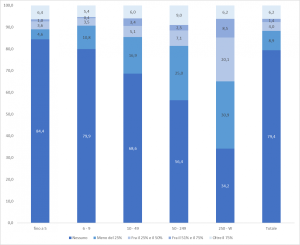PRESS RELEASE
WORK, INAPP: ‘REMOTE WORK AT A STALL: ONLY ONE IN TEN EMPLOYEES WORKS FROM HOME”
AT LEAST FOUR OUT OF TEN EMPLOYEES COULD WORK FROM HOME
Fadda: “A non-fully-exploited opportunity, at least for the moment. Working a job that can be performed from home does not necessarily mean that workers are allowed to do so. The data suggests that the change brought by the pandemic was only temporary. It seems that going back to normality thwarted the progress made during the pandemic on innovating the ways of working by involving in-presence and remote activities.”
Rome, 26 January 2023. Remote work is no longer on the rise. In Italy, only 14.9 percent of the employed people perform part of their activity remotely, while incidence could be around 40 percent considering the potential of teleworking. Therefore, despite the stark increase at the height of the pandemic which saw a rise from 4.8 of the previous year and 13.7 percent in 2020, remote work is only performed by a few.
These are some of the findings in the latest analysis by Inapp which was presented today at the event ‘Agile work, definition and measurement’ held in Rome at the Inapp auditorium. The workshop was attended by Sebastiano Fadda (INAPP President), Michael Frosch (ILO), Leonello Tronti (University of Roma Tre), Patrizia Cinti (Pontifical Antonianum University of Rome), Fiorella Crespi (Milan Polytechnic), Alessia Sabbatini (Istat), Daniele Di Nunzio (Giuseppe Di Vittorio Foundation), Francesca della Ratta, Rosita Zucaro and Tiziana Canal (INAPP), and Santo Darko Grillo (Director General of INAPP).
“Working a job that can be technically performed remotely”, said Inapp President Prof. Sebastiano Fadda, “is a necessary, but not sufficient, condition for actually working in a hybrid setting. The data tells us that the share of remote work varies from 25% for intellectual or executive professions to 2% for unqualified ones. Behind this distribution there is certainly the different degree of feasibility of remote working in the different professions, but also the different managerial capacity to adopt new models of work organisation using new digital technologies’.
A first cue comes from employers in the non-agricultural private sector: for companies with up to five employees, 84% of workers perform tasks that cannot be performed remotely, but as the size of the company increases, this share decreases (56.4% among medium-sized companies, 50-249 employees and 34.2% among companies with over 250 employees). In 2021, only 13.3% of the companies surveyed used this mode of work.
According to the analyses presented today, remote jobs are mainly held by university graduates, employees of large companies, people working in services and civil servants. Slightly higher than average incidences of remote jobs are found among women, who are based in the North West and the Centre, and people with a diploma.
“The data, therefore, shows that the shift in the work paradigm that the pandemic seemed to have triggered, at least in our country, did not take place” continued Fadda. “It is as if during the pandemic we were living in a ‘big bubble’ and with our return to normalcy, we have also gone back to old ways of working, essentially thwarting the potential of remote work. This is likely due to the inability to introduce radical innovations in the organisation of work that involve in-presence and remote activities.”
In 2019, only 14.6 percent of employed individuals in Europe (EU-27) habitually worked from home and the scenario was rather heterogeneous, with the Netherlands being an outlier with 37.2 percent. With the spread of Covid, countries that were already above the average in 2019 embarked on an upward trend in the two following years (Ireland, Luxembourg, Belgium, Finland, Denmark, France, Estonia, Malta and Portugal). Italy, which in 2019 was below the EU average also went on an upward trend that doubled the figure during the health emergency, however, in 2021 the uptake of remote work slowed down (4.8% in 2019, 13.7% in 2020, 14.9% in 2021 according to EU-LFS data, with even lower values among employees: from 1.7% in 2019 to 12.1 in 2020 and 13.8 in 2021).
The perception of some advantages and disadvantages of teleworking also reveals a gender difference with men, who particularly value greater autonomy, and women, who instead show greater concern about career prospects (50.9%), trade union rights and protections (52.8%) and greater control by the employer (53.3%).
“Share of workers who can perform remote tasks by UL size”.

For more information:
Giancarlo Salemi – INAPP President Spokesperson (347 6312823)
Allegati
Download the press release